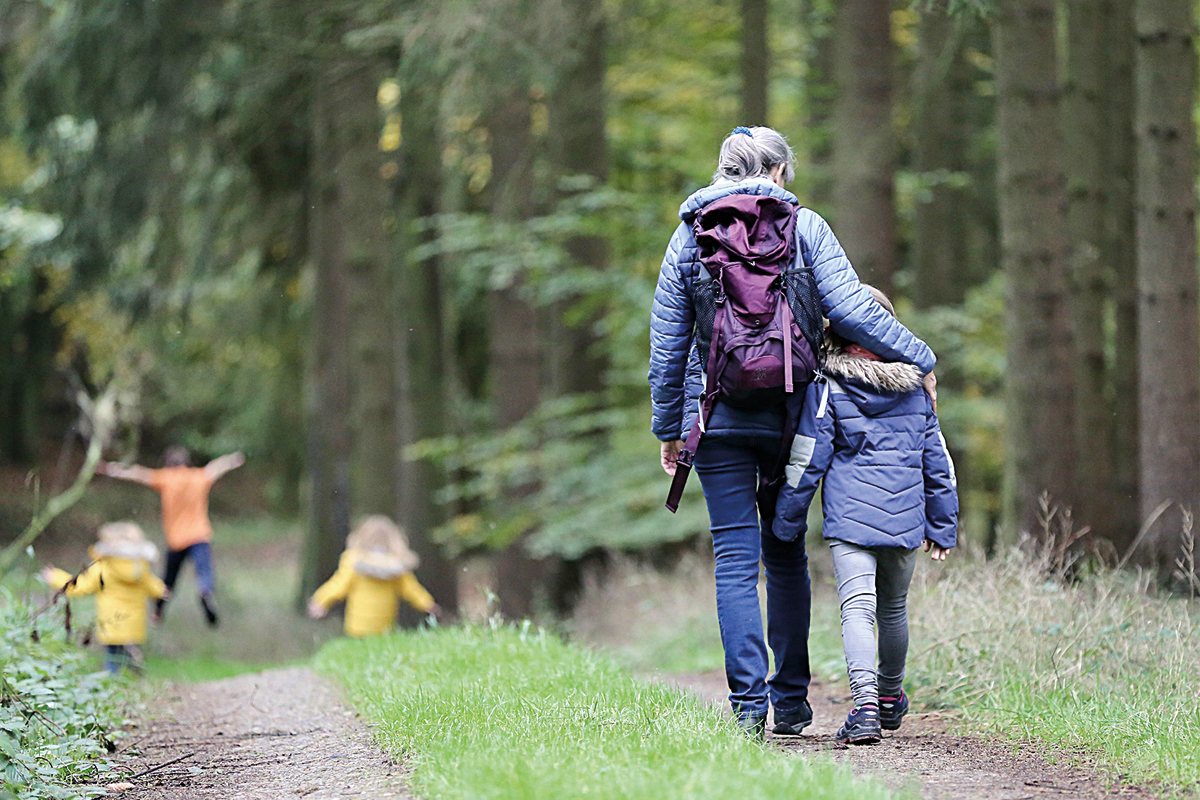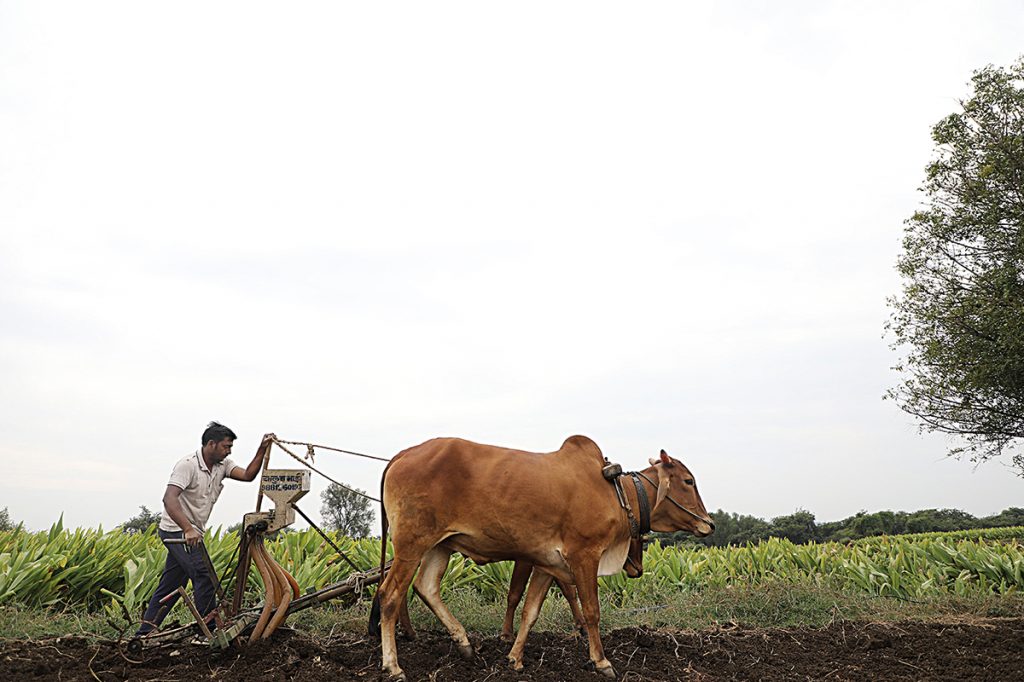More biodiversity to improve our health
The benefits to human well-being of favouring functional and diverse ecosystems

There is ample evidence that contact with nature generates measurable benefits for people’s psychological and physiological health. There is also abundant research showing that well-conserved ecosystems with high levels of biodiversity serve additional functions, including the reduction of risks to human health from animal-borne infections (zoonoses such as Covid-19) or climate change. The United Nations first coined the concept of One Health specifically to encourage the multidisciplinary study of human health in the global context of animal, plant, and ecosystem health, thereby enabling progress towards more preventive and effective medicine.
Keywords: biodiversity, ecosystem services, One Health, zoonoses, prevention.
A rich and functional nature is the best medicine
The diversity of life on Earth is strongly affected by human alterations to its ecosystems, but these impacts also work in the opposite direction. Indeed, it is now well documented that biodiversity affects the properties of ecosystems and thus, also the benefits that humans obtain from them. Human health, also in a broad sense, is therefore closely linked to biodiversity and the state of conservation of ecosystems. The World Health Organisation defines health as a state of physical, mental, and social well-being, rather than the mere absence of disease or infirmity. Experts also describe health, or health and well-being, as including factors such as a supportive environment, personal security, freedom of choice, social relationships, adequate employment and income, and access to educational resources, and cultural identity (Díaz et al., 2006).
Our sense of well-being is strongly dependent on the specific cultural, geographical, and historical context in which different human societies develop and is determined by socio-economic processes and the provision of ecosystem services. However, the well-being of the vast majority of human societies is based, more or less directly, on the sustained provision of critical ecosystem services such as the production of food, fuel, regulation of the quality and quantity of the water supply, and the control of natural hazards, etc. A well-conserved natural environment, therefore, plays an essential role in these broad and integrative definitions of human health and thus, human health and well-being is considered to be the ultimate cumulative ecosystem service (Sandifera et al., 2015).
There is a large base of growing literature demonstrating that contact with nature (broadly defined as including urban green spaces, parks, and forests, etc.) can produce measurable benefits for psychological and physiological health. Enjoying nature can have positive effects on healing, heart rate, focus, stress levels, blood pressure, behaviour, and other health factors (Brown & Grant, 2005). For example, contemplating nature, even through a window, improves recovery following surgery (Ulrich, 1984). Indeed, people’s well-being is enhanced by biodiversity and habitat variety in urban green spaces, as Fuller et al. showed in their classic 2007 paper.
A species-rich ecosystem provides more resources and is capable of supporting more ecological processes, as well as possessing so-called emergent properties such as resilience, i.e., a greater capacity to recover after disturbances or stressors. These features of ecosystems with higher biodiversity are derived from effects such as species complementarity that allow for a more efficient use of resources. Thus, in numerous ecosystems, both herbaceous and forested, biodiversity has been found to increase key ecological processes such as productivity (Liang et al., 2016).
«Our sense of well-being is determined by socio-economic processes and the provision of ecosystem services»
Those most directly dependent on ecosystem services, such as subsistence farmers, people in poor rural areas, and more traditional societies, face the most serious and immediate risks of the loss of biodiversity and environmental degradation (Díaz et al., 2006). First, they are the most dependent on the «safety net» provided by the biodiversity of natural ecosystems in terms of food security and sustained access to medicinal products, fuel, building materials, and protection against natural hazards such as storms and flows. The inequality in this dependence is also manifested, in many cases, where the provision of services is subsidised for the most privileged sectors of society, leaving the most vulnerable to bear most of the cost of biodiversity loss. This is the case for subsistence farmers versus industrial agriculture and for subsistence fishermen versus intensive commercial fishing and aquaculture. For example, when water quality deteriorates as a result of fertiliser and pesticide inputs from industrial agriculture, the poorer population cannot afford to buy safe drinking water. When protein and vitamins from local sources such as game and fruit decline because of habitat depletion, only the rich can continue to buy them. Therefore, there is an intense vicious circle between health, inequality, and the environment, which makes the loss of ecosystem services further accentuate the inequality and marginalisation of the most vulnerable sectors of society. This is because it reduces their access to the basic materials required for a healthy life and decreases their freedom of choice and ability to act.
Biodiversity loss and environmental degradation are inextricably linked to poverty, the greatest threat to humanity’s future according to the United Nations. This is a challenging conclusion for those who consider biodiversity to be only an intellectual preoccupation for people whose basic needs and aspirations are already well covered. Even the health of the richest is strongly influenced by the degree of conservation of ecosystems because many of the processes that impact our health operate on a global scale and, like pandemics or climate change, are not limited to a specific region or sector of the population.
The direct relationship between health, well-being, and biodiversity
Apart from all the positive effects mediated by the ecosystem services maintained or amplified by biodiversity, a range of hypotheses have identified direct positive connections between biodiversity and human health and well-being (Aerts et al., 2018; Hartig et al., 2014).
The biophilia hypothesis proposes that humans have an intrinsic affinity with other species and with nature because interaction with the natural environment drove our own evolution. According to this hypothesis, people prefer biologically diverse environments and obtain psychological benefits from being exposed to green spaces. Many of the studies addressing this hypothesis are framed by stress recovery theory, according to which natural environments facilitate recovery from physiological stress, as well as attention restoration theory, which states that natural environments facilitate recovery from mental fatigue and help restore directed attention (Aerts et al., 2018).
The biodiversity hypothesis proposes that exposure to biodiversity improves the immune system by regulating the composition of species in the human microbiome. According to this hypothesis, exposure to a beneficial environmental microbiota reduces the prevalence of allergies, asthma, and other chronic inflammatory diseases. The hygiene and microbiota hypotheses are interrelated and state that reduced early-life exposure to environmental parasites and bacteria is associated with an increased risk of developing allergic diseases, asthma, and other hypersensitivity disorders because of detrimental effects on the development of the human gut microbiome (dysbiosis) and the infant immune system (Aerts et al., 2018).

Those most directly dependent on ecosystem services, such as subsistence farmers, people in poor rural areas, and more traditional societies, face the most serious and immediate risks of the loss of biodiversity and environmental degradation. / Arnol Sonar – Unsplash
The dilution effect hypothesis proposes that high species richness of vertebrates reduces the risk of human infectious diseases because pathogens are diluted among a larger number of animal reservoir species with different abilities to infect invertebrate vector species. According to this hypothesis, the transmission and burden of infectious diseases is expected to be lower in natural environments rich in animal species because the prevalence of infected vectors is lower, despite the higher variety of pathogens (Aerts et al., 2018).
Benefits for physical health: the case of zoonoses
We fail to appreciate many of the services provided by nature – we might not even be aware of them – until they disappear. This was the case with Covid-19, a zoonotic disease that became a pandemic as the result of a combination of factors, including the impact of humans on biodiversity. Zoonoses are human infectious diseases caused by pathogens shared with other vertebrate animals. While pristine natural areas with high biodiversity were once considered likely sources of new zoonotic pathogens, it has been observed that the emergence of zoonoses is associated with habitat degradation and alteration, rather than their initial levels of biodiversity. Emerging infectious diseases were abundant in temperate regions during the 1940–2004 period, as shown by Jones and her colleagues (2008). However, the risk of these infections is currently increasing in tropical regions, in parallel to their deterioration (Allen et al., 2017). In fact, Southeast Asia, where Covid-19 originated, was postulated as being at particular risk for zoonoses three years before this specific pandemic was confirmed. Covid-19 is therefore a consequence of the global crises of biodiversity loss and environmental health.
We now know that biodiversity reduces the transmission of some pathogens that have already become established in human populations. Moreover, animal species most likely to harbour pathogens dangerous to humans tend to proliferate in human-dominated landscapes, increasing the likelihood of contagion. However, in less disturbed areas, these zoonotic reservoir species are less abundant and non-reservoir species predominate. Thus, the loss of biodiversity seems to increase the risk of human exposure to both new and established zoonotic pathogens (Keesing & Ostfeld, 2021). Biodiversity restoration is an important tool in zoonotic disease risk management and should therefore be considered a public health service.
Benefits for physical health: atmosphere purification and waste management
Biodiversity supports ecosystem services for mitigating heat, noise, and air pollution, all of which trigger positive health effects in well-preserved ecosystems and green spaces in general. Air pollution is the fourth most important risk to human health and is responsible for some nine million deaths each year. Furthermore, we now know that urban and peri-urban forests can counteract this health risk by contributing to air purification. For example, such forests were found to support the removal of particulate matter (PM10) and ozone (O3) in ten metropolitan cities in Italy (Manes et al., 2016). Structural characteristics of forests such as leaf area index and functional diversity, linked to stomatal conductance, had a significant influence on the provision of these regulatory ecosystem services, with a total monetary value estimated at about 350 million US dollars per year. Thus, these kinds of results should be taken into account when designing urban forests, parks, and gardens, considering issues other than shading, adaptation to the city’s climate, and rapid growth.
Microorganism biodiversity is also crucial for many toxic waste disposal processes and to clean up soils and waters that are potentially hazardous to human health. Indeed, various technological approaches mimic nature and exploit the potential of different microbial communities. Biological and industrial wastewater treatment plants employ biotechnological processes and their importance is growing in an ever-developing human society. Most wastewater treatment processes exploit the natural self-purification resulting from microbial activity, and their composition and dynamics are key to their performance (Antunes et al., 2021). Once again, nature and one of its main features, biodiversity, are essential elements in safeguarding human health.
Mental health
There is ample evidence of the mental health benefits of interacting with nature. For instance, Sandifera et al. (2015) provided a comprehensive review of the psychological and cognitive benefits – in addition to the physiological, social, and disease-regulating benefits – of interacting with well-preserved natural spaces. Outdoor exercise in a natural environment improves morale and self-esteem and is more restorative than outdoor exercise in an urban environment. In more than half of the studies reviewed, participants’ moods and attitudes were significantly more positive after engaging in outdoor activity compared to indoor activity. Indeed, participants reported greater revitalisation, self-esteem, positive engagement, vitality, energy, pleasure, and delight as well as less frustration, preoccupation, confusion, depression, tension, and tiredness after activities performed outside. Green spaces in urban areas also have the potential to mitigate other factors that negatively affect human health, such as poor air quality and the effects of heat stress (Brown & Grant, 2005).
On the one hand, in an extensive study of urban green spaces in Australia, Schebella et al. (2019) found that vegetation cover was consistently correlated with psychological benefits for visitors. Structural diversity of vegetation in urban spaces also had a positive effect on people’s moods. On the other hand, a study by Engemann et al. (2019) revealed that the risk of psychological disorders (schizophrenia, drug abuse, obsessive-compulsive disorder, anorexia, bipolar disorder, depression, and anxiety, etc.) from adolescence to adulthood decreases according to the amount of green space near one’s home during childhood. Interestingly, the trend was found everywhere from rural to urban areas and from villages to the centre of large cities.
Fewer hospitals and more prevention
There is growing evidence that ecosystems with a high level of biodiversity are likely to be more efficient in providing many multiple ecosystem services (the functional theory of biodiversity and ecosystems). Diverse systems have also proven to be more resistant and resilient to natural and anthropogenic disturbances, a characteristic that is even more important in urban and generally degraded or man-made environments. The properties of species-rich ecosystems with high ecological functionality underpin multiple processes that support human health and well-being.

Air pollution is the fourth most important risk to human health and is responsible for some nine million deaths each year. Urban and peri-urban forests can counteract this health risk by contributing to air purification. / Photoholgic – Unsplash
Today’s health problems are often complex, cross-sectional, multi-factorial, and involve many species and so approaching them from a purely medical or veterinary point of view is unlikely to lead to robust prevention and mitigation strategies. The funding for hospitals, vaccines, and treatments far outweighs investment in prevention and mitigation, which gives the impression that we are forgetting something: when someone is admitted to a hospital or is vaccinated or treated, they, or many others before them, have already had to suffer through an acute medical problem before that treatment had been invented. Maintaining ecosystems rich in species and ecological processes is both a fruitful and cost-effective strategy for managing potential health problems, and one of the best ways to prevent health disorders in the human population. The evidence supporting this conclusion has strengthened the One Health concept, now promoted for several decades by the United Nations.
The One Health framework focuses on responses, actions, and consequences at animal–human-ecosystem interfaces, especially in the case of emerging and endemic zoonoses. It also addresses antibiotic resistance, which can develop in humans, animals, or the environment, and can spread from one to the other and from one country to another. Other aspects such as food safety and a reduction in pollution are other objectives of One Health. Nonetheless, the titular concept of One Health, coined in 2003, is not new and dates back at least two hundred years, first as «One Medicine», then «One World, One Health», and finally under its current name. There is no single, internationally agreed definition of the term, but most commonly, it describes it as a collaborative, multi-sectoral, and transdisciplinary approach to health, encompassing the health of all living things, not just humans. The concept works at the local, regional, national, and global levels, with the ultimate goal of achieving optimal global health outcomes by recognising the interconnected relationship between humans, animals, plants, and their shared environment. This concept, coupled with a greater emphasis on prevention supported by well-preserved ecosystems, is a bright prospect for a civilisation beset by new and growing health problems. Examples abound: encouraging the coexistence of different bird species in a given region reduces the risks to human populations from infectious diseases such as the West Nile virus; maintaining minimally-fragmented, species-rich forests reduces the rates of ticks infected with Lyme disease bacteria; restoring biodiversity and protecting predators maintains functional ecosystems in which both regular prey and other species are healthier, thus reducing risks to humans and domestic animals; species-rich forests are more efficient at regulating local climate and mitigating heat waves associated with climate change. All these situations reveal the potential to address human health within the broad context of «One Health», with all its ecological and social components.
References
Aerts, R., Honnay, O., & Nieuwenhuyse, A. V. (2018). Biodiversity and human health: Mechanisms and evidence of the positive health effects of diversity in nature and green spaces. British Medical Bulletin, 127(1), 5–22. https://doi.org/10.1093/bmb/ldy021
Allen, T., Murray, K. A., Zambrana-Torrelio, C., Morse, S. S., Rondinini, C., Di Marco, M., Breit, N., Olival, K. J., & Daszak, P. (2017). Global hotspots and correlates of emerging zoonotic diseases. Nature Communications, 8, 1124. https://doi.org/10.1038/s41467-017-00923-8
Antunes, T. C., Marconatto, L., Borges, L. G. A., Sueli, A. G., & Van Der Sand, T. (2021). Analysis of microbial community biodiversity in activated sludge from a petrochemical plant. Revista Ambiente & Água, 16(3). https://doi.org/10.4136/ambi-agua.2655
Brown, C., & Grant, M. (2005). Biodiversity and human health: What role for nature in healthy urban planning? Built Environment, 31(4), 326–338.
Díaz, S., Fargione, J., Chapin, F. S. III, & Tilman, D. (2006). Biodiversity loss threatens human well-being. PLoS Biology, 4(8), 1300–1305. https://doi.org/10.1371/journal.pbio.0040277
Engemann, K., Pedersen, C. B., Arge, L., Tsirogiannis, C., Mortensen, P. B., & Svenning, J. (2019). Residential green space in childhood is associated with lower risk of psychiatric disorders from adolescence into adulthood. PNAS, 116(11), 5188–5193. https://doi.org/10.1073/pnas.1807504116
Hartig, T., Mitchell, R., de Vries S., & Frumkin, H. (2014). Nature and health. Annual Review of Public Health, 35, 207–228. https://doi.org/10.1146/annurev-publihealth-032013-182443
Fuller, R. A., Irvine, K. N., Devine-Wright, P., Warren, P. H., & Gaston, K. J. (2007). Psychological benefits of greenspace increase with biodiversity. Biology Letters, 3, 390–394. https://doi.org/10.1098/rsbl.2007.0149
Jones, K., Patel, N., Levy, M. Storeygard, A., Balk, D., Gittleman, J. L., & Daszak, P. (2008). Global trends in emerging infectious diseases. Nature, 451, 990–993. https://doi.org/10.1038/nature06536
Keesing, F., & Ostfeld, R. S. (2021). Impacts of biodiversity and biodiversity loss on zoonotic diseases. PNAS, 118(17), e2023540118. https://doi.org/10.1073/pnas.2023540118
Liang, J., Crowther, T. W., Picard, N., Wiser, S., Zhou, M., Alberti, G., Schulze, E., McGuire, A. D., Bozzato, F., Pretzsch, H., De Miguel, S., Paquette, A., Hérault, B., Scherer-Lorenzen, M., Barrett, C. B., Glick, H. B., Hengeveld, G. M., Nabuurs, G., Pfautsch, S., … Reich, P. B. (2016). Positive biodiversity-productivity relationship predominant in global forests. Science, 354, 6309. https://doi.org/10.1126/science.aaf8957
Manes, F., Marando, F., Capotorti, G., Blasi, C., Salvatori, E., Fusaro, L., Ciancarella, L., Mircea, M., Marchetti, M., Chirici, G., & Munafò, M. (2016). Regulating ecosystem services of forests in ten Italian metropolitan cities: Air quality improvement by PM10 and O3 removal. Ecological Indicators, 67, 425–440. https://doi.org/10.1016/j.ecolind.2016.03.009
Sandifera, P. A., Sutton-Grierb, A. E., & Ward, B. P. (2015). Exploring connections among nature, biodiversity, ecosystem services, and human health and well-being: Opportunities to enhance health and biodiversity conservation. Ecosystem Services, 12, 1–15. https://doi.org/10.1016/j.ecoser.2014.12.007
Schebella, M. F., Weber, E., Schultz, L., & Weinstein, P. (2019). The wellbeing benefits associated with perceived and measured biodiversity in Australian urban green spaces. Sustainability, 11(3), 802. https://doi.org/10.3390/su11030802
Ulrich, R. S. (1984). View through a window may influence recovery from surgery. Science, 224 (4647), 420–421. https://doi.org/10.1126/science.6143402





